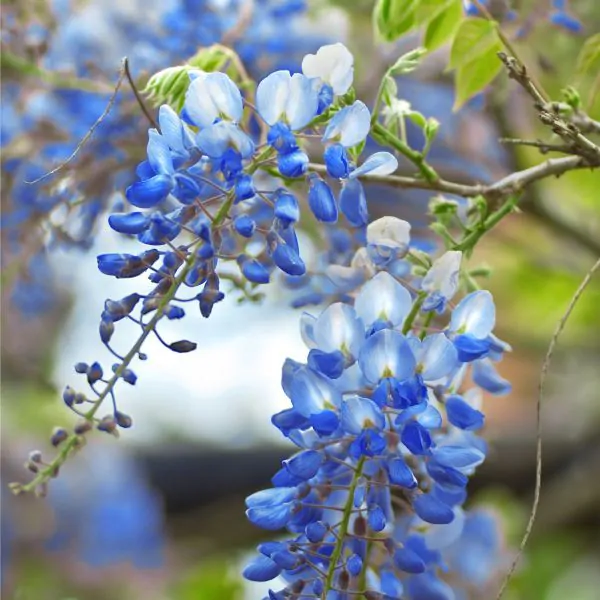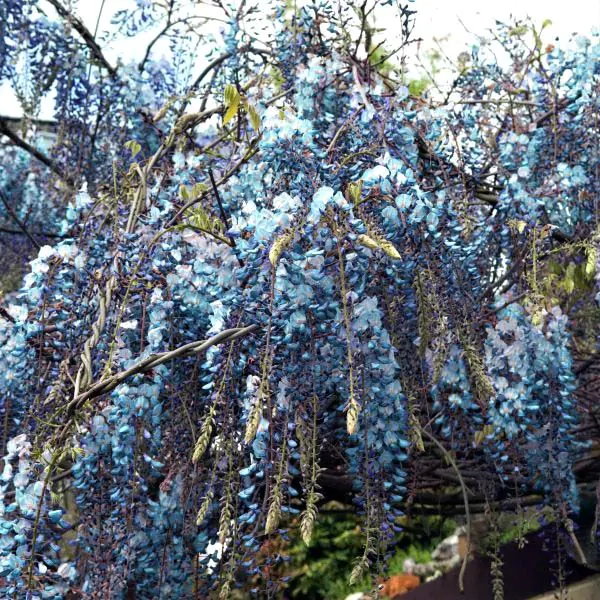Blue Wisteria is famous for its vibrant eye-catching cluster of blue flowers and it is loved by all the garden lovers globally. Since Blue Wisteria is native to China it is known as “China Blue Wisteria”. The fabulous showers of flowers, the vine in growing nature, the Bloom season in spring, the ability to tolerate partial shade, and the deciduous nature create a year-round appealing view hence making it a symbol of elegance in gardens worldwide.
Importance
The elegant blue flowers in spring appeal to the eyes during the scorching sunny days along with wide adaptability to soil types, ability to withstand both direct sunlight and partial shade, resistance against several diseases, ideal for various formations in the landscape, adaptive to a wide range of temperature and requirement of relatively less care to the established plant have collectively made Wisteria an ideal choice for any design of both landscape expert of the garden lovers.
Site Selection for new plantation
It is believed to be ideal for pergolas, arbors, trellis, or any location in lawn however before plantation following aspects need to be considered so that it can add desired productive value to the site.

Sun Light
The flowering depends upon the amount and quality of sunlight whereas the Wisteria thrives well in full sunlight and partial shade thus making it an ideal choice for most gardens.
Soil and Drainage
The plant loves to grow in well-drained soil with slightly acidic or neutral in nature whereas the presence of a substantial amount of organic matter is plus for the growth of the plant.
Plantation
The new plantation of the wisteria plant needs care for its successful growth whereas the following steps are considered to be crucial for the establishment of a new plantation in the garden.
Preparation of Site
Prepare a pit before plantation is recommended for wisteria plants, the pit should be kept open for at least a week for solarization. The pit should be filled will leaf compost and silt soil to facilitate the initial root growth of plants thus ensuring the excellent success and survival of plants.
Planting
While planting a wisteria make sure the plant is placed in the center of the prepared pit and the roots have not been damaged. Fill the plant with excavated soil mixed with silt and leaf compost to facilitate root growth.

Watering and mulching
Water the plants after the plantation and keep the soil moist in order to ensure the success of newly planted saplings. Later on, watering depends upon the soil type and site; the key point is to not allow the soil to become dry. Apply the layer of mulch and it would be better if the mulch is organic (plant-based) it will facilitate plant growth by maintaining adequate soil moisture along with the addition of nutrients to the soil if the mulch material is organic.
Structure and support
The newly planted wisteria vine needs support for the proper vertical growth, and directions and for a desired structure such as a pergola, arbor, or garden trellis of the plant keeping in view the objective of the plantation. The plant should be attached with the help of gardening twine with the provided support to ensure straight upward growth.
The newly planted wisteria needs initial care for the proper development of plants so.
Care and Maintenance
The established wisteria vine requires some regular practices to ensure proper growth and flowering.
Watering
The established wisteria vine has a moderate water requirement in such a way that the soil moisture level is being retained however it should be kept in mind that the soil may not get over-saturated as otherwise it would probably result in stunted growth due to improper root growth.

Fertilizer and Pest/Disease Control
Garden fertilizer with a slow nutrient release mode is recommended for the wisteria plant during the late winter before the new growth to prepare plants for the coming blossom. The addition of leaf or garden compost during winter is also recommended for plants. Spider mites, garden caterpillars, and Aphids may attack the wisteria vine and they can be managed by the various broad-spectrum synthetic or organic pesticides available from garden shops. Wisteria is considered to be resistant to several diseases however regular inspection of plants is recommended to check for any possible attack.
Read: Banana water and peels for plants growth
Pruning
Pruning is the practice of removing unwanted growth of a plant to maintain its growth, promote regular flowering, and maintain overall structure. It is being carried out in late winter before the new growth season. The activity is carried out annually however regular pruning may require training the plant as per the desired structure.
Conclusion
The significance of Wisteria is appreciated by both garden lovers and professionals since it is liked globally due to the above-mentioned universal features. The unique flowering habit of wisteria in combination with its ability to adopt various formations in landscape design contributed to its wide adaptability in garden design. Despite the initial care of the new plantation, the established wisteria does not need any special care. It can be concluded that wisteria can be declared one of the most ideal flowering climbers and it is a good choice for the garden.



